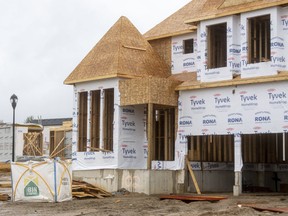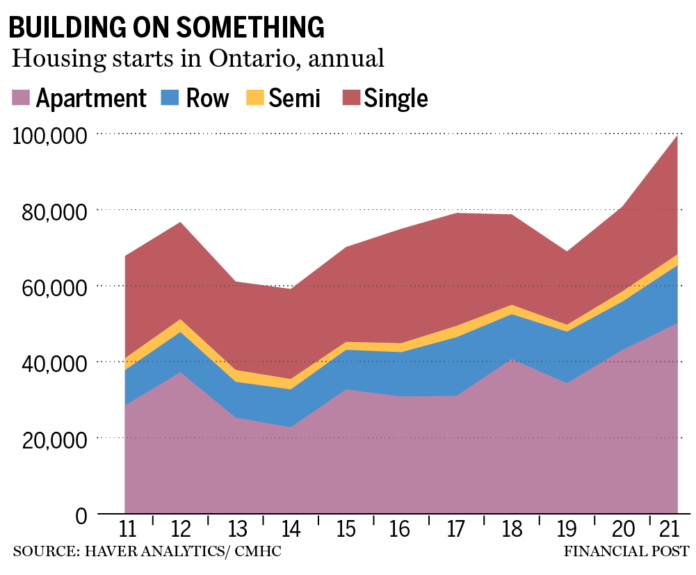Breadcrumb Trail links
The widening gulf between housing prices and incomes is frustrating Ontarians
Publishing date:
Feb 10, 2022 • 19 hours ago • 4 minutes read • 8 comments  House sales center in Carleton Place. Photo by ERROL MCGIHON/Postmedia files
House sales center in Carleton Place. Photo by ERROL MCGIHON/Postmedia files
Article content
A lack of housing supply has once again been called the most significant contributor to worsening housing affordability in Ontario and, by extension, Canada.
advertisement
This advertisement has not been loaded yet, but your article continues below.
Article content
A new report by the Ontario Housing Affordability Task Force said simply that not enough homes have been built, contributing to the erosion of affordability in Ontario.
The task force has come up with dozens of recommendations to improve the situation, identifying measures to reward municipalities that proactively build new housing and limit naysayers’ ability by proposing restrictions on the stalling powers of local governments and NIMBY (not in my back yard) residents .
The task force pointed out average incomes in Ontario have increased by 38 per cent since 2011, but housing prices have almost tripled. The widening gulf between housing prices and incomes is frustrating Ontarians.
Its report said demand-busting measures to cool housing markets have either not worked or provided only temporary relief. This should be an essential finding for supply skeptics, who exclusively blame foreign buyers, investors and others for Ontario’s rising prices and rents.
advertisement
This advertisement has not been loaded yet, but your article continues below.
Article content
The task force presented several examples of how it takes years to get approval for new construction in Ontario. Such delays add millions of dollars to construction costs. In addition, local governments have adopted regulations and practices that exceed Ontario’s Planning Act provisions and are responsible for dragging out consultations, further delaying the supply of much-needed housing.
 It takes years to get approval for new construction in Ontario. Photo by Mike Hensen/The London Free Press/Postmedia Network
It takes years to get approval for new construction in Ontario. Photo by Mike Hensen/The London Free Press/Postmedia Network
Even when professional planning staff recommend new developments, municipal councils sometimes reject the proposal or require additional compliance that can take months or years to do, causing delays or outright abandonment of the project.
The task force identifies the nexus between the NIMBY residents and NIMTO (not in my term of office) politicians, who have combined to successfully slow the pace of residential development. The NIMBYs, who often use the pretext of preserving a neighborhood’s character, hold leverage over municipal councillors. Even when a development proposal makes sense, the councillors turn into NIMTOs.
advertisement
This advertisement has not been loaded yet, but your article continues below.
Article content
Even without explicit municipal approval, the report recommends housing proposals be “as of right,” or approved automatically without rezoning, to disarm the NIMBYs and NIMTOs. For example, if city authorities delay a proposal to densify an area near a transit station, the planning approvals should happen automatically, given the apparent benefit of improving population densities near transit stations.
Furthermore, the report recommends placing limits on endless public consultations and proposes punitive damages against those whose delay tactics are motivated by sheer self-interest.
The report also recommends streamlining myriad planning regulations that differ by municipalities or even within municipalities in an effort to remove ad hoc decision-making and reduce uncertainty.
advertisement
This advertisement has not been loaded yet, but your article continues below.
Article content
The report’s most important recommendation is the target to build 1.5 million more homes in the next 10 years. But that much construction will require much more than just countering the NIMBYs and NIMTOs given that Ontario only started construction on 817,000 dwellings in the past 10 years.
Building an additional 800,000 homes over what would have been built normally will require some major initial steps, such as access to developable land, construction loans at favorable terms, availability of skilled labor and stable supply chains for construction materials.
Consider accessibility to developable land as an example. The report estimates that almost 70 per cent of the land in Toronto is reserved for single- or semi-detached dwellings. Such exclusionary zoning practices must be eliminated across Ontario by using provincial mandates that override any local bylaws against situating new development in already built-up areas.
advertisement
This advertisement has not been loaded yet, but your article continues below.
Article content
-

Busting the myth of Canada’s million or more vacant homes
-

Investors are no more to blame for housing prices now than they were before
-

Canada can’t just tax its way out of its housing conundrum
However, it would be naive to assume that all new construction will be absorbed in the built-up areas, warns David Amborski, a professor at Ryerson University and a member of the Task Force. “Developable and serviced land is in short supply for infill and greenfield development,” thus requiring more serviced land to accommodate hundreds of thousands of new Ontarians.
An increase in construction activity will likely worsen trade and skilled labor shortages. But the federal government can play a significant role here by prioritizing skilled labor for immigration. Furthermore, the feds can partner with the provincial government to leverage funding for new developments, especially purpose-built rental housing, and enhance the ability of the proposed Ontario Housing Delivery Fund.
advertisement
This advertisement has not been loaded yet, but your article continues below.
Article content
Similarly, the federal government can strengthen supply chains that bring construction materials from overseas and other parts of Canada.
One way or another, the task force’s recommendations must be implemented to address rapidly escalating housing prices. The provincial government has an opportunity to base its reelection strategy on enhancing housing supply for the upcoming provincial elections in June.
Millions of Ontarians whose housing plans were frustrated by growing prices and rents are likely to reward solid platforms to tackle the worsening housing affordability.
Murtaza Haider is a professor of Real Estate Management at Ryerson University. Stephen Moranis is a real estate industry veteran. They can be reached at the Haider-Moranis Bulletin website, www.hmbulletin.com.
Share this article on your social network
advertisement
This advertisement has not been loaded yet, but your article continues below.

Financial Post Top Stories
By clicking on the sign up button you consent to receive the above newsletter from Postmedia Network Inc. You may unsubscribe any time by clicking on the unsubscribe link at the bottom of our emails. Postmedia Network Inc | 365 Bloor Street East, Toronto, Ontario, M4W 3L4 | 416-383-2300
Thanks for signing up!
Comments
Postmedia is committed to maintaining a lively but civil forum for discussion and encouraging all readers to share their views on our articles. Comments may take up to an hour for moderation before appearing on the site. We ask you to keep your comments relevant and respectful. We have enabled email notifications—you will now receive an email if you receive a reply to your comment, there is an update to a comment thread you follow or if a user you follow comments. Visit our Community Guidelines for more information and details on how to adjust your email settings.


















